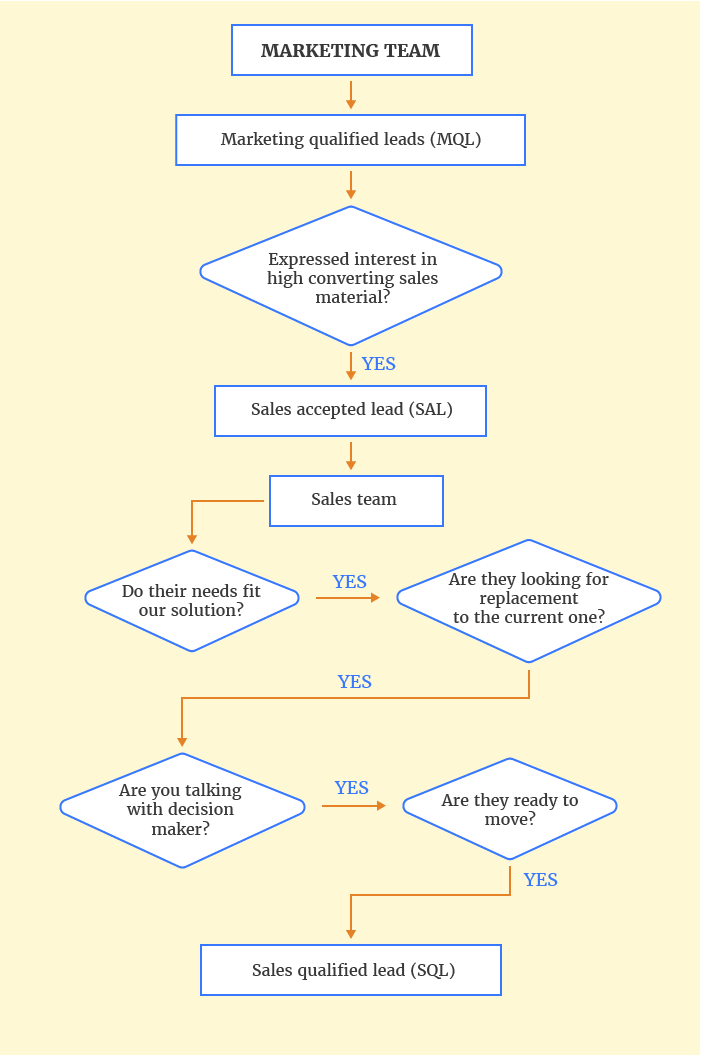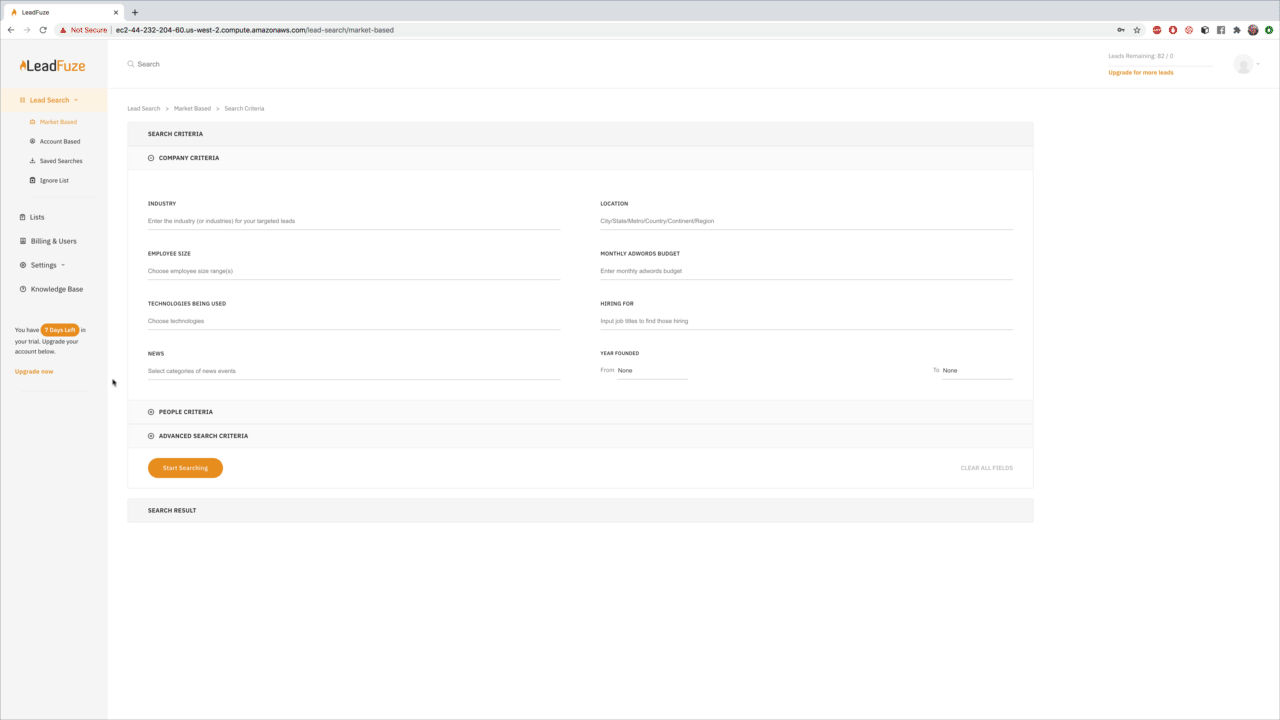What is a Sales Qualified Lead?
A sales qualified lead is a prospective customer that has a high probability of converting into a sale. Two things must be clear for Sales to qualify a lead:
- The lead has expressed an interest in your product or service,
- The lead has the financial means to complete the purchase.
In other words, a lead should have taken actions that show their interest and intent to buy for Sales to conclude that they are ready for a sales call. Sales leads are identified by the sustained interest in your solution.
A lead is unlikely to respond positively to a sales call if they have not actively inquired about your product or engaged with your marketing. Neither will they if they lack the means or decision-making power to purchase your product
For instance, if your company manufactures tires, a person who has visited the tire section of an auto store and is comparing tire options might be considered a lead that is now ready to talk with a sales rep.
Below is the path a lead takes until they become a sales qualified lead.

SQL Vs. MQL: Difference Between a Sales Qualified Lead and a Sales Qualified Lead
A marketing qualified lead (MQL) is a potential customer that the marketing department considers promising enough to nurture. The lead is typically in the early stages of their buyer’s journey (awareness and interest) and would convert their interest into a purchase decision if properly nurtured.
MQLs are by nature not ready to buy. Unlike sales qualified leads, MQLs are not ready to talk to a sales rep because they still not sure the solution meets their needs or if it delivers adequate value. They would like some time (or marketing help) to come to the right buying decision.
When marketing nurtures a lead, they are essentially driving content they deem to be appropriate for the lead’s current stage on the buyer’s journey. This is essentially an assumption as there is no direct communication with the lead at this stage.
How about an illustration?
Marketing qualified leads are receivers of content suggested to them by marketers. If one person does all the talking, it’s a lecture. You’re lecturing an audience to entice them to learn more about your product. You are giving a grand image of a world that can be created with the things you sell.
Marketing is more of a grand lecture and when your “students” begin to raise their hands—you begin to have a conversation.
Sales (especially with higher ticket items) always involves a conversation.
The biggest difference and indicator that your marketing leads may be sales-ready is their willingness and desire to turn your lecture into a conversation. Not that marketing doesn’t involve interaction.
Social media, opt-in forms, email responses are all types of communication that can happen during the marketing phase. These are commonly known as engagement. These things (among others) help a team score the lead to gauge sales readiness.
The biggest difference between engagement within the marketing funnel and a lead looking for conversation is what/who they interact with.
Again, this may differ from one company to another. A few examples may include:
- Webinar Registration/Attendance: Depending on the content. If it’s geared more toward your target industry/audience, it may not move the leads to sales. Although, if it explains X ways your product improves Y—it could be close.
- Email Response: This is a much clearer indication of sales readiness. If you send a resource or other means of communication via email and the lead responds with some questions, they may be ready to have a fit call.
- Filling Out a Contact Form: Having ways for visitors to reach out on the site could be an easy way to pick out those who were further along in the process than you thought. Be ready, though. The faster the response, the more likely you are to land a conversation.
Interesting: One study shows that you could be up to 100 times more likely to get a conversation with a lead if you can respond within five minutes. Only 5% of companies strive to do so.
The concept of a sales qualified lead assumes that there are leads that Sales may deem not ready for a sales call. This suggests a discord between Marketing and Sales, specifically that Marketing is too eager to hand leads over to Sales.
So the question becomes, how do you produce leads that Sales is more likely to accept and qualify?
16 Ways to Increase Sales Qualified Leads
Sales managers have the greatest incentive to pursue only those leads they can successfully sell to – their closure rates. By chasing poor quality leads that have not shown strong signs they are ready to buy, their closure rates take a tumble.
Worse, it is a major point of frustration for sales reps to struggle to close sales not because their pitches are weak but because the leads are simply not ready or interested enough to buy.
So if your sales closure rates are low, before reworking your pitches, maybe consider the quality of leads you are sending down to sales. Here are some of the ways you can produce more sales qualified leads:
1 Know your leads
Studying your leads to gain a thorough understanding of their needs helps you accurately determine when they are now ready to be sold to by a sales rep.
The knowledge you gain of your leads enables you to segment them by their interest level. That interest tells where they are in their journey with your product and, importantly, what content you must drive to them to urge them toward a purchase decision.
2 Automate prospecting through social media
Social media is one of the best ways to generate leads organically. It allows you to build relationships with prospective customers at no cost and on a platform they are most comfortable with because they willingly go there to socialize.
Right off the bat, you know leads that start conversations around your product or solution or is mentioned to engage with posts where your product has some interest in what you are selling. It is like a lead that comes pre-qualified – they aren’t simply a name and an email address.
Automation allows you to get started with as little work or cost as possible. With alerts set up for specific keywords, for example, automation ensures that you don’t miss any sales opportunity because of you.
3 Ask for more contact information
Most forms on your website ask for a name and an email address, but you can also enable leads to submit their other contact information through the form.
This is especially important if you’re using landing pages or have an e-commerce site with products people want to buy right away.
On the other hand, a person who shares their phone number is telling you they are ready to take a sales call from you because they have already done their research on your product. People who aren’t looking to buy what you selling don’t typically give away their phone numbers.
4 Set up lead magnets
Lead magnets are freebies that people can receive in exchange for their contact information. They are a common lead generation technique that works.
Offering something of value like a whitepaper, cheat sheet or even just an eBook will make it worth your prospects’ time and get them to give you their name and email address in return.
The fact a lead is downloading an ebook or whitepaper means they are genuine in your product is genuine – that they are probably deepening their research.
That type of content – like whitepapers, case studies, and ebooks – is typically consumed by leads that are in the middle to latter stages of their buyers’ journey – people who should soon be ready to take a sales call.
5 Create lead capture form fields on your website
If you’re using a website to generate leads Sales is more likely to qualify, you should make sure people are willingly giving up their contact information. But that does not mean constant pop-up forms that block content and annoy the life out of readers.
It means creating forms that tell people specifically why you want their contact information. An example is, ‘fill the form below so that we send you more information on how to use [your solution] to improve [prospect pain point].
Make sure to make it worth their time and effort to download your lead magnet in exchange for their contact information. Put some effort into producing a truly helpful resource that gives the lead the information they are looking for.
6 Create an “opt-in box
The opt-in box is a white box on your website that features the lead magnet you’re offering and asks prospects to give up their contact information in exchange for it.
You can also add social media buttons or icon links if people want to follow you there as well, encouraging more engagement with your brand. This way, you’ll be able to capture the prospect’s name and email address in one fell swoop.
7 Engage and delight your leads
Once you have a lead’s contact information, how soon they are ready for a sales call all comes down to one thing: how well you can engage and delight them.
Don’t make it so obvious that you are only interested in the sale. Sending an email that offers value before asking for anything is the best way to go about this.
Work on building trust with your prospects before asking for anything in return. Create and share helpful content that establishes a mutually beneficial relationship. Encourage them to reply to emails with questions on anything that isn’t clear to them. Then personally reply to the emails.
You will also want to use email marketing software that allows you to segment your list of contacts by their interests, so you can send them more personalized emails on a regular basis. It’s up to the marketer how often they want to contact their leads, but you should probably test to find the sweet spot.
8 Use SEO to pre-qualify leads
Search engine optimization is the practice of aligning your existing content to topics your target leads are searching for online and creating topics you know your target prospects are actively researching.
When done right, SEO helps you raise your rankings for keywords that are relevant to your business and generally improves your visibility on search engines.
Using SEO, you can be sure the people reading, watching, and engaging with your content have a genuine interest in the product because you are not writing about random subjects.
Still on SEO, here’s a related way to increase sales qualified leads:
9 Target long-tail keywords
Long-tail keywords are phrases that have a lower search volume but also higher conversion rates. They are more specific and tell you more about the intent behind the search.
For example, “green tea recipes” would be more specific than just “tea recipes”. The latter could generate many pages of content whereas the former only has a few.
With that search, you know the searcher is not interested in any other teas that are not ‘green’. So if you don’t sell green tea, this ‘lead’ has no chance of converting. Sales will not accept or qualify it even if Marketing has passed it off as ‘qualified’.
10 Avoid sending too many emails
Don’t bombard your prospects with emails, but don’t be afraid to send a few either.
If you want them to subscribe for more updates and offers, make sure they know about it in the first email or two by including a link that says “Subscribe here!” at the bottom of those messages.
Too many emails can backfire because a prospect may feel like they’re being spammed and stop reading or clicking on any of your messages. Meanwhile, you are thinking they should be further down their buyer’s journey and likely ready to handed over to Sales.
If you send too few, you may frustrate prospects that want to finish their research as soon as possible and proceed to make the purchase. The result is prospects may seek this information from competitors and end up converting with them instead, when you are thinking they are closer to buying from you.
11 Select the right promotional channels
Promote your offers via channels that are the most appropriate for your business.
The best way to determine which channel is right for you is by considering where potential customers spend their time and what types of promotion they are most comfortable with – PPC ads, search ads, social media ads, etc.
For example, if you’re a restaurant owner, you may want to promote your specials through social media rather than television.
12 Create a tight sales funnel
The goal of a sales funnel is to get as many potential customers into the top level (the widest part) and have a filter that can effectively separate leads that aren’t a fit.
At this point in your marketing strategy, you should offer something that’s valuable and helpful on its own for free such as an ebook, webinar, coupon code, etc.
If and only after they go through all three levels of your sales funnel, should you consider handing them over to Sales?
13 Score your leads early
A good way to know which leads have the greatest chance of passing Sales’ typically tough qualification criteria is by scoring them on specific characteristics. And you want to do early in the buyer’s journey to eliminate suspects from genuine prospects.
The higher the number, the more time and effort you’ll want to put into that lead because they seem like better bets. You should determine a threshold (a score beneath which) where a lead is simply not worth the time and effort.
14 Integrate marketing with a capable CRM platform
It’s crucial to use a capable CRM as soon as someone fills out the form on your website and becomes a lead- which is usually when they do their first search for keywords related to what you’re selling– then that information will automatically be sent to your CRM and you can start working with them.
One of the best CRM tools out there is LeadFuze.
LeadFuze is a CRM designed specifically for marketing and sales teams that want to stay on top of their leads.
It eliminates the need for tedious manual data input, enabling you to spend more time closing deals!
Furthermore, it can help you find sales-qualified leads because it’s also a lead generation tool that helps you find and qualify the best prospects for your business, so you can have more time to focus on what really matters.
LeadFuze has helped companies of all sizes find their next big customer. With LeadFuze, you get access to thousands of pre-qualified leads every month with no strings attached.
You don’t need to worry about wasting hours searching through databases or paying expensive fees just to reach out and see if someone is interested in your product or service. This tool will do all the work for you! All you have to do is pick up the phone and start making calls!

Get started generating better quality leads with a free trial of LeadFuze today.
Consider Running Google Adwords
Running Google ads can be a great way to boost the quantity and quality of your leads, but it’s also expensive and time-consuming. Though the ads require expert PPC advertising knowledge and take time to set up, run reports, and take care of other administrative tasks that come with advertising.
You can use Google’s advanced targeting tools to laser-focus your ads on a specific market segment. Using our tea example, you can set your ads to show to green tea drinkers and not tea drinkers in general.
If people are clicking on your ads but not buying anything from your site or giving their information so that they can be contacted later, it might mean that your ads have been low-performing. Among your option for fixing this would be:
- A/B Testing: This can involve testing out different options for your ad in order to see which version is more effective or what you want people to respond to most. You could also use this test as a way to see if your ad should be heavy on text or visuals.
- Personalization: This means using people’s names, interests, location, and other personal information when advertising with Google Adwords so that only those who might be interested and can access your product will actually click on the ad for a better chance of a conversion.
The Importance of Qualifying Leads in Sales
Overall, a sales qualified lead is the key to a successful business. Even it is not their job to attract and generate leads, ultimately it is Sales that knows what a good quality lead that is likely to convert looks like.
It does not help the company increase sales to just fill the sales pipeline with any prospects that hand you their contact information. These should be people that have shown a strong interest in your product and can afford to buy it.
The ideal setup should be for Marketing and Sales to work together and have a common understanding on what a good, promising lead looks like. The two departments must agree on how to qualify a sales lead.
With such an understanding, lead qualification by Sales is a formality because Marketing would have done all the necessary legwork, and the chances that they will convert into a paying customer will be similarly high.
Now that you are familiar with the sales qualified leads definition, how they differ from a marketing qualified lead, and the different ways you can produce them, go get those leads and start selling to people who genuinely want to be sold to.
Want to help contribute to future articles? Have data-backed and tactical advice to share? I’d love to hear from you!
We have over 60,000 monthly readers that would love to see it! Contact us and let's discuss your ideas!

